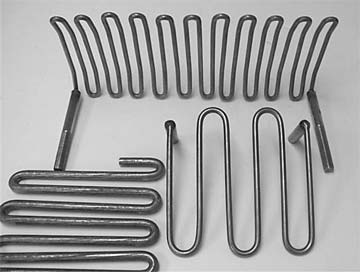Rod Heating Elements Review
Industrial, Testing, and Engineering Equipment
Rod Heating Elements Review
Rod Heating Elements are cylindrical heating components of various lengths designed and manufactured straight or containing curves and radii. Typical Rod Heating Elements consists of 2 GA. (.258 DIA.) and are mounted vertical or horizontal on enclosure walls, floor, and door. Most rod elements include a jog to locate the heating element away from the surrounding insulation and enclosure. Rod elements are typically located, secured and extended using electrical clamps and connectors of various types. Heavy and light duty application rod elements accommodate 240 volt, 3 phase VAC.
Rod heating elements generally are extremely rugged and used within high temperature furnaces and other applications. Industrial heating applications include material tempering, hardening, normalizing, stress relieving, sintering, baking, adhesive curing, vacuum and dip brazing, nitriding, carburizing, Laboratory applications, industrial applications, aluminum/zinc die casting, furnaces for non-ferrous metals, glass processing furnaces and carbonitriding. Rod heating elements are typically engineered and manufactured as inseparatable single element pieces from graphite or silicon carbide grains sintered at temperatures of 2400°C or more. Rod elements are ideal for rugged and caustic atmospheres as the materials are very resistant to complex chemicals. Typical application temperature ranges are from below 600°C to 1600°C in both air (oxygen and nitrogen) and controlled atmospheres. Special coatings can improve heating elements life cycle in challenging operating environments.
 Courtesy Custom Electric Manufacturing Co. |